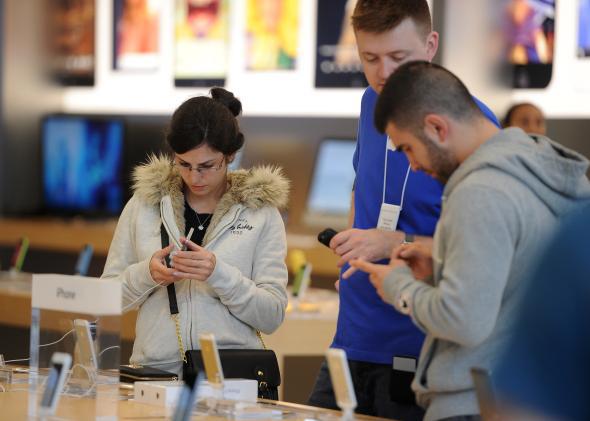I bought a new iPhone 5S on Tuesday. It cost hundreds of dollars and in some sense is a waste of my money since my existing phone works fine. But I love gadgets, so what the heck. Except excitement about the new phone rapidly turned to outrage as I reached the very last step of the process. In addition to the price Apple was charging me, I had to fork over $30 to Verizon for no reason.
Well, not for no reason. I had to do it because otherwise I couldn’t get the phone.
But the money’s not in exchange for any kind of service. I already pay Verizon—handsomely—for the privilege of connecting my phone to their network. About a year ago, I committed to pay them every month for a two-year span. So as of this September, I can’t buy a phone on another carrier without paying Verizon a healthy cancellation fee, and I can’t buy a Verizon phone without forking over a “one-time upgrade” fee. Except, of course, there’s nothing one-time about it. They charge the fee any time you want to upgrade. AT&T charges $36!
In a more detached, non-enraged mode, I would say there’s a valuable lesson here in the real-world economics of pricing. In a moralistic folk worldview, prices should in some sense be “fair.” In an introductory-economics-textbook worldview, prices should be equal to marginal cost.
Since it doesn’t cost Verizon anything to let me upgrade my phone—it involves literally no action of any kind on their part—both fairness and marginal cost theory agree that I should be able to upgrade for free. But real businesses don’t care about fairness, and relatively few real businesses operate in the kind of highly competitive markets that introductory textbooks deal with. You can’t just wake up one morning and decide to start a new nationwide mobile phone operator. And if you did, AT&T and Verizon could just take an 18-month break from being jerks, drive you out of business, and then go back to their old ways. So even if you wanted to build a competitor, nobody would give you the money to do it.
You’re just screwed. And in fact, you’re more screwed than you realize. Consumers have been trained to think that benevolent mobile phone operators “subsidize” biannual phone purchases. These subsidies are actually loans offered at a crazy-high interest rate. Now that T-Mobile is offering “unsubsidized” iPhones and cheaper data plans, we can calculate the real price of the subsidy fairly precisely.
The cheapest T-Mobile plan costs $50 a month, and offers unlimited talk and text plus 500 MB of data.* Verizon will give you the same for $80. At AT&T, $80 will get you just 300 MB of data and 450 monthly minutes of phone use. So Verizon offers you a $450 up front discount on your iPhone. In exchange, you pay them a $30 premium every month for 24 months. That extra $30 a month is enough to repay the $450 discount, plus give Verizon $270 in extra revenue.
That $270 works out to an interest rate of 30 percent a year. This is, admittedly, better than the rates offered by payday lenders to the desperate and poor. But it’s wildly higher than interest rates that middle class iPhone-buying types would accept for a mortgage, a car loan, or student debt. Needless to say, as soon as my Verizon contract expires I’ll be switching.
Then there are the little games the carriers play regarding things like using voice or data service abroad. There’s nothing expensive about providing global roaming, but the upcharges for it can be immense. If you’re headed to Asia for business next week, you have few convenient options beyond just paying what your carrier demands.
The government could—and should—step in to ameliorate some of these problems. Mobile phone operators used to keep customers trapped by saying that if you switched from one company to another you’d need a whole new phone number. Then in 2003 the FCC made carriers knock it off. They could do something similar with the upgrade fees.
But to really fix these problems, the companies that make the phones are going to have to step up. Back before the original iPhone, things were even worse. In the bad old days, the carriers insisted on running the stores where you could buy apps and ringtones (remember ringtones?). They saw every minor phone modification as another chance to rob customers. Apple insisted on changing the terms of the business and reducing the carriers’ role. But more recently, they’ve grown complacent. Apple’s own website presents pricing information in a manner designed to perpetuate the myth that the AT&T/Verizon subsidy model is a good deal for consumers. And Google, rather than seizing the opportunity to outflank Apple by taking on the carriers, has strengthened their hand. Android’s “open” nature means that carriers can lard it up with crapware.
Given the formidable barriers to competition in this industry, carrier malfeasance is a problem that’s genuinely hard to solve. But if the mobile phone industry is to advance, this is where most of today’s big gains are to be had. Faster processors and better cameras will keep coming, to be sure. But whoever takes the next great leap forward in mobile will have to bring the carriers to heel.
Correction, Sept. 26, 2013: The initial version of this article overstated the amount of bandwidth covered in these plans by an order of magnitude. They offer hundreds of megabytes not hundreds of gigabytes. (Return to the corrected sentence.)
